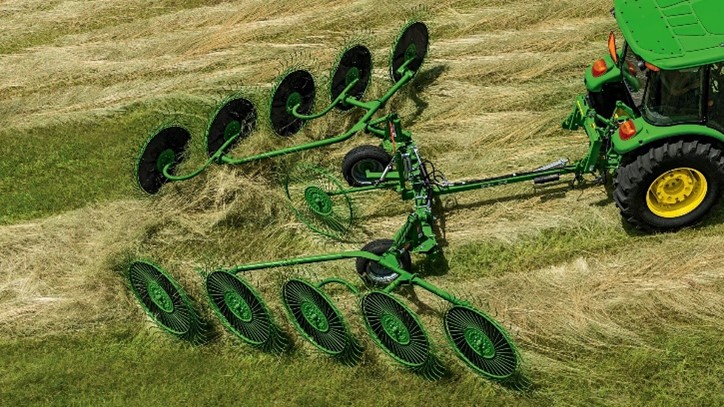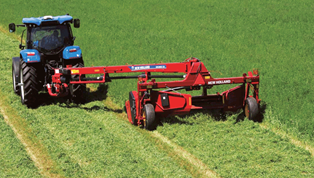Dry forages: Process and techniques
Problem
Forage storage and quality are affected by the percentage of water contained in the plants. A high water content encourages the formation of mould and indigestible compounds from a reaction between sugar and amino acids (Maillard reaction) and brown forage. Enzyme processes can also modify forage quality due to plant respiration after cutting. A decrease in forage quality is also due to weather conditions during haymaking.
Solution
To increase water loss after cutting, grass needs to be spread with an appropriate machine (tedder) to expose more surface to the sun. When moisture content is around 45-50 %, the grass is turned. Rowing the grass at night reduces surface area and water reabsorption as well as increasing soil drying (Figure 1). This helps to decrease drying time and reduce losses in forage quality and quantity.
Benefits
The drying process preserves forage quality and increases protein and energy content. To improve the process, a conditioner can be attached to the mower where the grass is crushed between two rollers. Crushing the stems can speed-up the on field drying process, reduce nutrient losses and, if the drying process is completed in a hay dryer, reduce the energy consumption.
Applicability box
Geographical coverage
Global
Application time
Growing and harvesting time
Required time
A few days of dry and sunny weather
Period of impact
October – June
Equipment
Hay-making machinery, tedder, mower, baler
Best in
Alfalfa, grass.
Practical Recommendations
- To obtain the best forage quality, cutting at the correct time is important, when cellulose and lignin content is not too high. During spring, cutting early is the best option to preserve forage quality; for grasses, the correct time is beginning of heading; for leguminous plants, it is beginning of blooming. However delaying cutting increases dry matter (DM) content, which speeds up the drying process. Favourable weather conditions can reduce drying costs. Making hay decreases the moisture content to 15 % and increases dry matter (DM) to 85 %. Cutting height (Figure 2) is important for a perennial crop, affecting speed and quantity of regrowth. Generally is not recommended cutting too close to the ground, because basal buds are the slowest to refill and have low vigour.
- Spreading the grass at cutting helps to decrease drying time and minimise forage quality and quantity losses. On field crushing of stems using a conditioner, increases water loss by up to 30 % and increases DM. The drying process can be completed on the field or in drying rooms, where forage quality is highest. At the end of the drying process, the hay can be baled and stored.
Further information
Video- The Character & Heritage Institute: Video «The process of making hay».
- Check the Organic Farm Knowledge platform for more practical recommendations on animal husbandry and livestock feeding.
About this practice abstract and OK-Net EcoFeed
Publishers:Associazione Italiana Agricoltura Biologica (AIAB),
IT89035Bova Marina (RC),
Phone +39 0965 764992,
,
aiab.itResearch Institute of Organic Agriculture (FiBL),
CH5070Frick,
Phone +41 62 865 72 72,
info.suisse@fibl.org,
www.fibl.orgIFOAM Organics Europe,
BE1000Brussels,
Phone +32 2 280 12 23,
www.organicseurope.bio,
www.organicseurope.bio
Review: Lindsay Whistance, ORC, UK
Contact: eugeniopapi1@gmail.com
Permalink: https://organic-farmknowledge.org/tool/37881
https://orgprints.org/view/projects/OKNetEcoFeed.html
This practice abstract was elaborated in the Organic Knowledge Network on Monogastric Animal Feed project. The project is running from January 2018 to December 2020. The overall aim of OKNet EcoFeed is to help farmers, breeders and the organic feed processing industry in achieving the goal of 100% use of organic and regional feed for monogastrics.
Project website: https://ok-net-ecofeed.eu/
IFOAM Organics Europe (project coordinator), BE; Aarhus University (ICROFS), DK; Organic Research Centre (ORC), UK; Institut Technique de l'Agriculture Biologique (ITAB), FR; Research Institute of Organic Agriculture (FiBL), CH; Bioland, DE; Associazione Italiana perl'Agricoltura Biologica (AIAB), IT; Donau Soja DS, AT; Swedish University of Agricultural Sciences, SE; ECOVALIA, ES; Soil Association, UK.



This project has received funding from the European Union’s Horizon 2020 research and innovation programme under grant agreement No 773911. This communication only reflects the author’s view. The Research Executive Agency is not responsible for any use that may be made of the information provided. The authors and editors do not assume responsibility or liability for any possible factual inaccuracies or damage resulting from the application of the recommendations in this practice abstract

